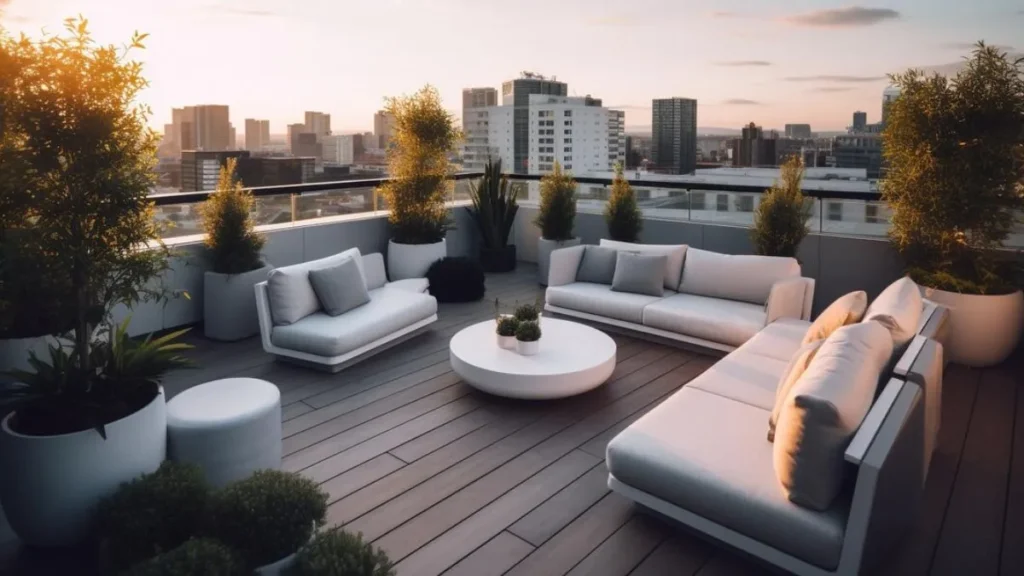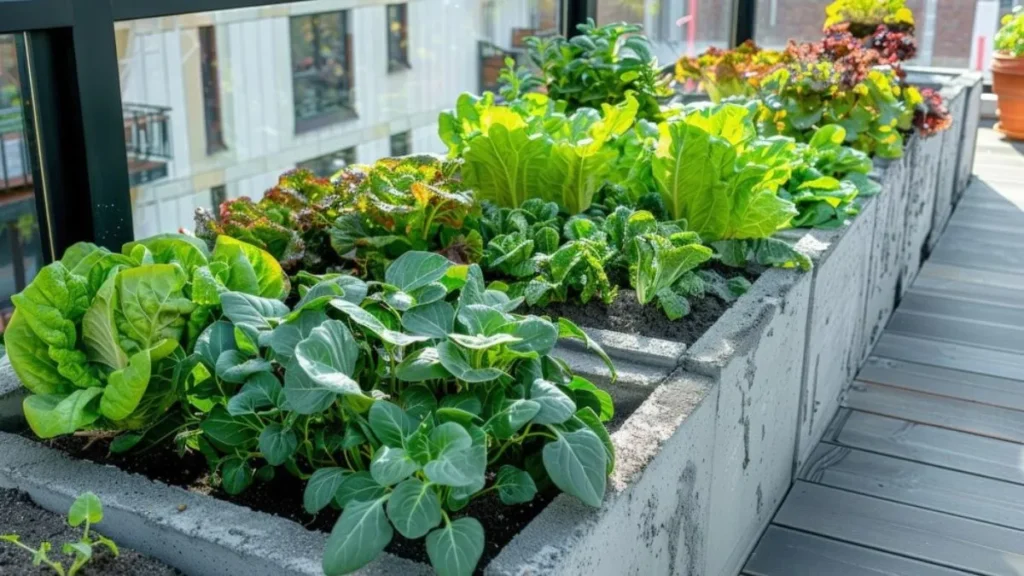One beautiful afternoon, standing on my rooftop, I felt as though the great expanse of flat, gray space over my head was being wholly squandered. My path into the realm of roof gardens started there—a rich, green haven where I could flee the everyday grind of city life. If you’re considering turning your rooftop into a garden, let me tell you my tale and some ideas for roof garden configurations that could realize your goal.
Benefits of a Roof Garden
Choosing to build a roof garden has brought many unanticipated pleasures into my life. Along the road, I came across several significant advantages as follows:
Aesthetic Appeal
A roof garden fundamentally alters the appearance of a structure. Rather than a dull, dead rooftop, my house gains appeal and character from a vivid, green area. Both friends and neighbors have complimented my living area on its focal point.
Environmental Impact
One of its most satisfying features is that my roof garden improves the surroundings. It improves air quality, lessens the urban heat island effect, and supports biodiversity. Seeing butterflies, bees, and birds in my yard brings back the natural world’s resilience.
Insulation
After building the roof garden, I found my energy expenses dropped noticeably. Acting as an insulating layer, the soil and plants help to keep my house warmer in the winter and cooler in the summer. It’s a natural approach to control house temperature and save energy usage.
Space Utilization
Many times, living in a city means little space. Turning my rooftop into a garden will help me optimize my land usage without requiring more acreage. This is a creative answer for city people who want greener living.
Mental Well-being
My preferred approach to relax is now spending time in my roof garden. Garding and being surrounded by nature have done miracles for my mental state. This is a quiet haven where I may find comfort and release from daily worries.
Challenges to Consider
Of course, creating a roof garden isn’t without its challenges. Here are some obstacles I faced and how I managed to overcome them:
Structural Integrity
Making sure my roof might handle a garden’s weight came first. To manage the weight of soil, plants, and garden elements, I spoke with a structural engineer who verified the requirement for more support beams. It was an absolutely vital outlay for the project’s lifespan and safety.
Waterproofing
Waterproofing was essential to prevent water damage to my home. I invested in high-quality waterproof membranes and drainage systems to protect the structure below. This step was non-negotiable and ensured peace of mind.
Access
Setting up and keeping the garden depends on simple access to the roof. I ensured there was enough room to move about comfortably and built a substantial staircase. Making the garden both valuable and entertaining depends on accessibility.
Cost
The first arrangement required a significant outlay. The expenses came to be between structural reinforcements, waterproofing, and buying plants and supplies. But I saw it as an investment in my property and well-being over time.
Weather Exposure
Rooftops experience more severe weather than ground-level gardening. I selected sturdy plants able to resist different temperatures and high winds. Establishing sheltered spaces and windbreaks further helped guard the garden.

Planning Your Roof Garden
Assessing Your Space
Before creating my roof garden, I had to assess the available space. Here’s what I considered:
- Structural Analysis: See an expert to be sure my roof can support the extra weight.
- Sunlight Exposure: Monitoring the sunshine patterns all day helps one select plants that will flourish in such an environment.
- Wind Exposure: Given the height of my building, planning for windbreaks to protect my plants was essential.
Budgeting for Your Garden
Creating a budget was a crucial step in managing expenses effectively. Here’s what I factored in:
- Structural Reinforcements: These were necessary to support the garden’s weight.
- Waterproofing and Drainage: Essential to protect my building.
- Plants and Soil: I chose a mix of perennials and annuals suited to rooftop conditions.
- Furniture and Accessories: Comfortable chairs and ornamental accents accentuate the garden’s appeal.
- Maintenance Costs: Funds for consistent maintenance—including fertilizers and pest control—are allocated here.
Design Ideas for Roof Garden
Here are seven ideas for roof garden designs that I found particularly inspiring and practical:
1. Creating a Relaxation Zone

A roof garden should be a sanctuary where you can unwind. Here’s how I designed my relaxation zone:
Comfortable Seating Options
I invested in weather-resistant furniture. My favorites are:
- Lounge Chairs: They’re great for reading or lying in the sun.
- Hammocks: They give off a tropical vibe and make for a cozy place to sleep.
- Outdoor Sofas: Creating a comfortable seating area for gatherings.
Adding Shade and Shelter
Protection from the elements is crucial. I added:
- Pergolas: Providing partial shade and a frame for climbing plants.
- Umbrellas: Offering flexible shade options.
- Gazebos: Creating a sheltered area for year-round use.
2. Incorporating Greenery

The core of any roof garden is its greenery. Here’s what worked for me:
Best Plants for Roof Gardens
I selected flowers that would flourish on a rooftop:
- Succulents and Cacti: Growing succulents and cacti is easy and doesn’t require much care.
- Herbs and Vegetables: Growing my own produce added functionality.
- Ornamental Grasses: Enhancing the garden’s texture and motion.
Vertical Gardens and Hanging Plants
Maximizing space with vertical gardens was a game-changer:
- Trellises and Arbors: Supporting climbing plants.
- Wall-mounted Planters: Utilizing vertical space for flowers and herbs.
- Hanging Baskets: Adding visual interest and saving floor space.
3. Water Features

Incorporating water features enhanced the tranquility of my roof garden:
Small Fountains and Ponds
I added the soothing sound of water with the following:
- Fountains: Various styles, from modern to classical.
- Ponds: Small ponds housing aquatic plants and fish.
Rainwater Harvesting Systems
Eco-friendly and practical, I used:
- Rain Barrels: Gathering rainwater for irrigation.
- Integrated Systems: Using collected water to maintain my garden, reducing reliance on municipal water supplies.
4. Edible Garden
Growing your food makes you quite happy. These are some guidelines:
- Herbs: Basil, mint, and rosemary thrived on my rooftop.
- Vegetables: In containers, Tomatoes, peppers, and lettuce did nicely.
- Fruits: Strawberries and dwarf fruit trees added a sweet touch.
5. Zen Garden
Creating a space for meditation and mindfulness was essential:
- Sand and Gravel: Raked into calming patterns.
- Stone Lanterns: Adding a serene, traditional feel.
- Bonsai Trees: Perfect for a Zen-inspired rooftop retreat.
6. Flower Garden

A vibrant flower garden can lift your spirits:
- Color Schemes: I chose a mix of colors for a lively display.
- Perennials: Making sure blossoms show year after year.
- Pollinator-friendly Plants: attracting bees and butterflies.
7. Entertainment Area
A roof garden can also be an excellent place for entertaining guests:
- Outdoor Kitchen: With a grill, sink, and countertop for cooking.
- Dining Area: A large table and chairs for meals.
- Lighting: String lights and lanterns for evening ambiance.
Important Links
Sustainable Roof Garden Practices
Creating a sustainable roof garden was essential to me. Here’s how I did it:
Using Eco-Friendly Materials
I opted for materials with a minimal environmental impact:
- Materials Recycled: Plastic, metal, and recycled wood
- Natural materials: Including bamboo and many renewable resources.
Efficient Irrigation Systems
Water conservation was crucial:
Drip Irrigation: Delivering water straight to the roots with drip irrigation helps to cut waste.
Smart Irrigation Controllers: Changing water plans according to the state of the weather.
Suggestions for Roof Garden Maintenance
Maintaining my roof garden ensured its longevity and health:
Regular Upkeep
Routine maintenance tasks included:
- Watering: It’s essential to ensure plants get enough water, especially when it’s dry outside.
- Pruning and Trimming: Trimming and pruning help keep plants neat and healthy.
- Weeding: Frequent weed removal helps to stop them from overrunning the yard.
Seasonal Care
I adjusted my care routine based on the season:
Spring and Summer: With an eye on development, fertilization, and pest control, spring and summer
Fall and Winter: Fall and winter call for bringing delicate plants indoors, installing protective coverings, or preparing them for colder conditions.
Conclusion
Building a roof garden was a transforming event that gave my house peace, beauty, and use. Through careful planning and weighing various roof garden ideas, I transformed a vacant rooftop into a lush, green refuge. Whether you intend to build a sustainable green space, relax, or produce food, a roof garden is an excellent addition to any home. Though the road could provide difficulties, the benefits are worth it. Thus, start that initial step and permit your rooftop to serve as the garden of your fantasies.
FAQ’s
What type of roof is best for a garden?
Because of their stability and simplicity of access, flat roofs are perfect for roof gardens. Sloped roofs can still be used with appropriate structural reinforcements and safety precautions.
Can I install a roof garden myself?
Although you might create a roof garden independently, structural inspections and waterproofing are advised to guarantee durability and safety.
How do I protect my roof from garden weight?
See a structural expert to ensure your roof can handle the extra weight. To disperse the weight equally, use lightweight soil mixtures and containers and consider modular garden solutions.
What are the best plants for low maintenance?
Roof gardens benefit significantly from low-maintenance succulents, cacti, and decorative grasses. These resilient plants demand little maintenance.
How can I ensure my roof garden is eco-friendly?
Use environmentally friendly supplies, clever watering systems, and composting and rainwater collection techniques to design a green roof garden. Select native plants that need minimal upkeep and water.

